In a groundbreaking study aimed at addressing a critical healthcare challenge, researchers have delved into the microbial profiles and antimicrobial resistance found in diabetic foot ulcers (DFUs) at a tertiary care facility in Northern China. This research is particularly significant given the rising prevalence of diabetes, which has transformed DFUs into a common complication affecting millions worldwide. The exploration of the microbial environment within these ulcers not only sheds light on potential pathogens but also has broader implications for treating infections that complicate diabetes management.
Diabetic foot ulcers serve as a complicated intersection of diabetes management and infectious disease. As diabetes progresses, circulation diminishes, and the risk of foot injuries escalates, creating an environment conducive to infections. These ulcers often lead to severe complications, sometimes culminating in hospitalizations, amputations, or even mortality. The research highlights a pressing need for comprehensive characterization of the microbial populations residing within these ulcers, providing a clearer understanding of the pathogens involved and their mechanisms of resistance.
The study employed advanced microbiological techniques to profile the microbiome inhabiting diabetic foot ulcers. Techniques such as metagenomic sequencing and culture-based methods allowed researchers to catalog a diverse array of bacteria. This detailed examination revealed a mosaic of microbial inhabitants, ranging from common pathogens like Staphylococcus aureus to less frequently encountered species. The implications of this microbial diversity are profound, particularly in guiding tailored antibiotic treatments that are crucial for effective patient care and recovery.
One of the most alarming findings from the study is the level of antimicrobial resistance among the isolated strains. The researchers discovered an alarming prevalence of multidrug-resistant organisms (MDROs) within the ulcers, which poses a direct threat to current treatment paradigms. The emergence of these resistant strains highlights the urgency for health professionals to rethink their strategies in managing infected DFUs. Currently available antibiotics may not effectively penetrate or eliminate these resistant strains, making the search for new therapeutic options an essential priority.
In addressing the issue of resistance, the study underscores the importance of stringent infection control measures. Poor management of diabetic foot infections often exacerbates the problem of resistance. Healthcare facilities should implement stricter guidelines for hygiene and care, along with protocols that discourage unnecessary antibiotic use. Such measures are crucial not merely for the individual patient but also for broader public health efforts aimed at curbing the spread of resistant strains.
Another vital aspect of the research is its implications for personalized medicine. By understanding the specific microbial populations that are prevalent in diabetic foot ulcers, healthcare providers can tailor their antibiotic regimens to not only the type of infection but also the patient’s unique microbiome profile. This approach could significantly improve treatment outcomes and reduce the length of hospital stays, showcasing a paradigm shift in the management of complications arising from diabetes.
Moreover, the study serves as a clarion call for ongoing surveillance of microbial resistance patterns. As the bacteria evolve and become increasingly resistant to conventional treatments, the medical community must remain vigilant in tracking these changes. Regular updating of local antibiograms and resistance profiles will empower clinicians to make informed decisions, ultimately refining patient management approaches in the face of evolving threats.
Equally significant is the focus on education and awareness. The study emphasizes the necessity of educating both healthcare professionals and diabetes patients about the consequences of poor foot care and self-management. Empowering patients with knowledge about the importance of early intervention and proper foot care can dramatically reduce the incidence of ulcers and the subsequent complications associated with them.
As diabetic foot ulcers remain a leading cause of morbidity in patients with diabetes, the implications of this research extend far beyond the study itself. It serves as a vital piece of the puzzle in understanding how best to combat a growing public health crisis. Addressing the interrelated issues of microbial profiling, resistance, and effective treatment paths is imperative for improving outcomes for diabetic patients.
In conclusion, the findings from this research not only contribute significantly to our understanding of microbial populations in diabetic foot ulcers but also serve to inform clinical practices in managing these complex infections. The exploration of these issues is a necessary step in combating the rising tide of antimicrobial resistance in an era where diabetes-related complications remain prevalent. As we advance towards a more tailored and informed approach to treating these ulcers, the hope is to see a reduction in complications and a better quality of life for those living with diabetes.
This study acts as a vital stimulant for subsequent research, encouraging investigators to explore novel therapeutic avenues and develop targeted interventions. The multifaceted approach to tackling the issues surrounding diabetic foot ulcers reflects a broader commitment to improving healthcare outcomes and enhancing patients’ lives globally.
Finally, the research highlights an essential perspective for the future – a collaborative effort between researchers, clinicians, and patients in managing diabetes and its associated complications. By combining scientific inquiry with practical interventions and patient education, there is potential to make a tangible impact on this widespread issue.
Subject of Research: Diabetic Foot Ulcers and Antimicrobial Resistance
Article Title: Characterization of Microbial Profiles and Antimicrobial Resistance in Diabetic Foot Ulcers at a Tertiary Care Facility in Northern China.
Article References:
Zhang, F., Yang, C., Li, M. et al. Characterization of Microbial Profiles and Antimicrobial Resistance in Diabetic Foot Ulcers at a Tertiary Care Facility in Northern China. Diabetes Ther (2025). https://doi.org/10.1007/s13300-025-01778-9
Image Credits: AI Generated
DOI: 10.1007/s13300-025-01778-9
Keywords: Diabetic foot ulcers, antimicrobial resistance, microbial profiling, infection control, personalized medicine.




